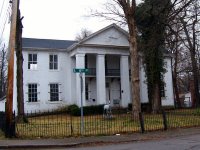History and Old Stuff...

I have a neat old book that I bought at an estate tag sale. Both of its covers are completely detached but all of the pages are still bound together, except three pages from the front. I don't think any pages are missing. To store it on the bookshelf, I stack the parts of the book in their correct order, tie them with ribbon like a package, and place the whole thing in a soft cloth envelope I made for it.
The book's poor condition makes it almost worthless, but I enjoy owning it. It is a 1903 edition of
Gaskell's Compendium of Forms. On the frontispiece (above, click to enlarge), the book's contents are summarized, and on another page, the following dedication appears.
--- To ---
The Young Men And Young Women
Of The
United States
Who Wish To Master At Their Own Homes
The Most Necessary Forms and Laws
of Business and Society,
This Book Is Affectionately Inscribed By
The Author.
The book's pages are embellished with many finely decorated drop caps (big fancy capital letters) at the beginnings of the various sections, as well as many other pen-and-ink illustrations and designs. Mr. Gaskell was a famous calligrapher who had already published a best-selling book about the art, so I assume he was the primary artist of the book. I don't know that for sure, but no other artist is given credit on the title page at the front of the book.
One section is dedicated to the subject of handwriting. He talks about the importance of sitting properly, using the right muscles, mastering various sorts of curves and slanted lines, and correctly spacing letters and words. The types of practice he suggests in his "Twelve Lessons In Penmanship" were still in use when I was introduced to the Palmer Method of cursive writing in the late 1950's.
Another section of the book is devoted to letter writing. Mr. Gaskell gives examples of suitable letters for nearly every occasion. For example, here is a suggested text "From a Gentleman to a Lady, Making a Declaration."
My Dear Miss Hunter:- You cannot but have been aware for some time past that my feelings toward you have been stronger than those of mere friendship. Our long acquaintance has given me ample opportunity to learn the excellences of your character, and to prize them at their full value. It has also afforded you a like opportunity to judge whether I possess those characteristics which you would desire in a husband. Am I presumptious in hoping that you will consent to become my wife? Until I receive your answer I shall remain,
Your anxious but no less ardent admirer, Charles Carter
Notice that the gentleman does not actually ask the lady to be his wife. He asks if he may presume to hope that she will consent.
I can't begin to list everything of interest in Gaskell's Compendium of Forms, but you can browse through
an online version of the book. It is not a complete replica, but it contains many interesting excerpts of the book's sections, as well as some of the illustrations. Or you can
buy your own copy at AbeBooks.




























